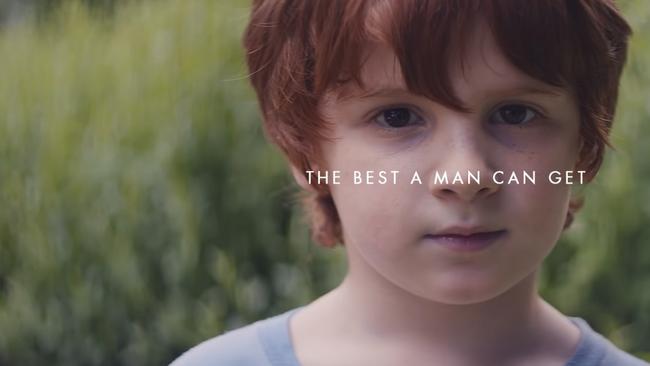Could Gillette’s new ad be nothing more than a cynical marketing ploy?
In all the controversy over Gillette’s latest ad, has anyone considered that it is just a cynical marketing stunt, asks Fred Pawle.
After a few repeated views of that Gillette ad everyone is talking about, an amusing thought starts to form. What if this is not a clumsy case of corporate social engineering but something a whole lot cleverer and funnier?
Once the initial dramatic effect wears off, the wokeness of the ad starts to look conspicuously cliched.
Boys wrestling and bullying, men ogling hot chicks and manning barbecues, chanting “boys will be boys”. Impressionable little angels appearing adorably naive in the face of poor male role models.

Then there is the racism: the white guys being mostly violent or lecherous and the black guys mostly heroes.
It’s all a bit textbook, don’t you think?
MORE OPINION
Mundine: Changing the date of Australia Day is not my priority
It’s true, teachers get too many holidays
The slow death of our health insurance system
For years, feminists have found myriad new reasons to hate men.
To hear them tell it, we cause climate change, take all the best jobs, get paid more, deny our own privilege, and only promote women who will sleep with us.
Plus, Donald Trump is a man, and so too are all his male colleagues, so we all must be bastards.
The Gillette ad generally ignores most of these tropes and instead, with the exception of a brief moment of boardroom patriarchy, focuses on the ancient complaints of male violence and lechery.

It looks like it was made a decade ago. Or more.
Granted, Gillette’s parent company, Procter and Gamble, is not known for creating cutting-edge advertisements, but neither is it a slouch in the marketing department.
P&G’s products are not unique. They sit on supermarket shelves alongside virtually identical products from other manufacturers.
Success in this arena relies on knowing the desires of the key demographics, which are not necessarily related to shaving, and targeting them accurately.
P&G dominates the sector. Gillette alone sells more than $US1 billion a year. Hearing any alarm bells yet?
Consider the blowback from men around the world after the ad was released.
If my theory is correct, the ad was deliberately designed to provoke revulsion and threats of boycotts from certain men, and every time the ad on YouTube hit another 100,000 dislikes, the Gillette marketing department cracked open another case of limited-edition Budweiser Reserve.

Not only were those dislikes less significant than most people assume, they indicated Gillette’s success in tapping into an arguably more lucrative market.
At the risk of sounding unfashionably incorrect, there are two main markets for Gillette’s razors: men and women.
Gillette’s male market is not what it used to be.
A lot of its customers switched over to the Dollar Shave Club, a razor delivery service founded in 2011, which was selling an estimated $US200 million worth of razors a year when it was snapped up by Unilever in 2016 for about $US1 billion.
Also, beards, a novelty a decade ago, are back, in a variety of shapes and styles.
Rock stars, TV presenters, politicians and business leaders are all giving the furry face a new level of acceptability.

For every dude wearing a neat dusting of whiskers, trimmed weekly with electric clippers, or full-length Ned Kelly, pruned annually with a set of garden shears, the demand for disposable razors is reduced by two or three per week. That’s millions of men’s razors a year.
Of the remaining men who still shave daily, how many are likely to be outraged by Gillette’s ad to the point of boycotting? Ten per cent? And of those, how many will maintain the rage? Very few, I imagine.
Eventually, their outrage will subside and they will return to their old buying habits.
Meanwhile, the instant outrage and chatter about the ad all over the world (to which this story contributes) will reinforce Gillette’s status as the most prominent brand to the majority of men who don’t care about all this gender-war malarky, and just want a reasonably priced, half-decent razor.

Women, on the other hand, still buy their razors in supermarkets. What’s more, they are accustomed to paying top dollar for beauty products (which is where the real sexism is).
It makes sense for Gillette to see this as the new key demographic.
One tried and tested way to tap the female market is to ridicule male stereotypes.
Check out the top comments about the ad on Gillette’s Facebook page — they are all from women expressing approval that Gillette is “helping evolve the world” and “taking action”.
Gillette’s responses to them are so fawning they make you cringe.
They are also as textbook as the ad itself — “Thank you for continuing the conversation!” and “We believe in the best in men and are glad to have your support.”

No need to apologise to men, obviously. Very clever.
So why is it also funny?
Have another look at the moment in the ad in which a female executive gets mansplained. This could almost be a scene from P&G’s boardroom itself.
If P&G really cared about female empowerment against the patriarchy, it would have more than nine women in its 30-person US executive team and four women on its board.
So this is a campaign by a male-dominated company using man-hating cliches to attract a female market.
If women fall for it, it will be the funniest joke of the year.



